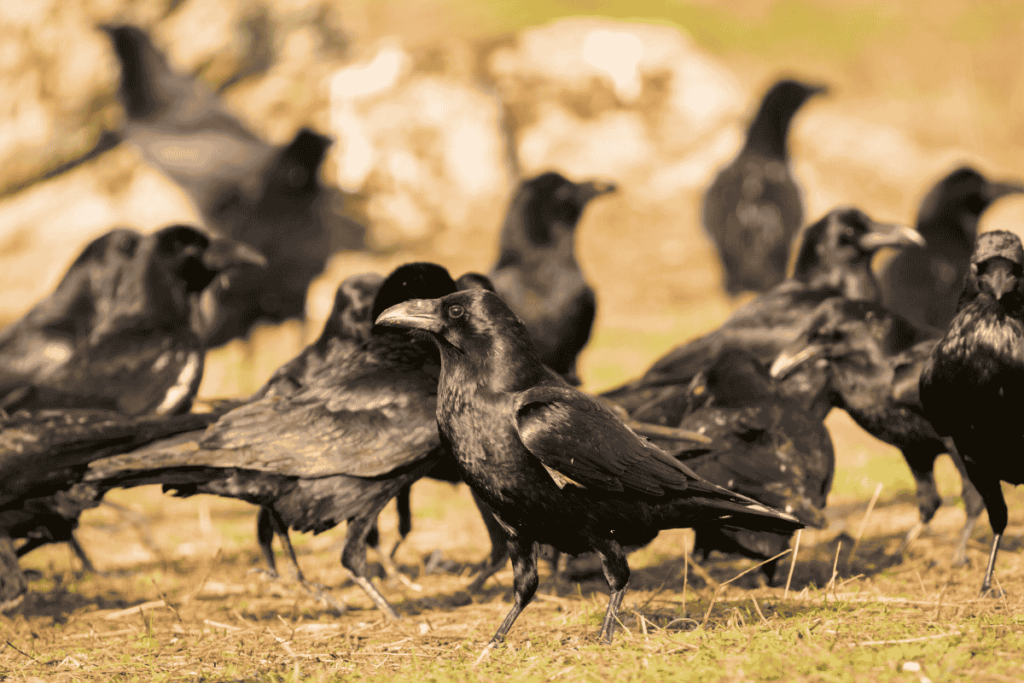We’ve all paused to watch a swarm of black shapes fluttering across the sky, crows gathering in large groups. It feels eerie yet fascinating. In this guide, we share everything we’ve learned about crow flocking behaviour: the real reasons behind those noisy assemblies, what benefits the birds gain, and how you can appreciate (or manage) their presence. We keep it conversational, clear, and packed with practical insights.
Table of Contents
- Crow Basics: Who They Are
- What We See: Flocks, Roosts, and Murmuration
- Key Reasons for Large Crow Gatherings
- Seasonal Patterns and Variations
- Anatomy of a Crow Roost
- Real-Life Stories Over Coffee
- Managing Crow Gatherings on Your Property
- FAQs About Crow Flocking Behaviour
- Conclusion: Embracing Crow Communities
Crow Basics: Who They Are
We start by getting to know our subjects. Crows belong to the corvid family, alongside magpies, jays, and ravens. They share traits like:
- High Intelligence: tool use, problem solving, memory for human faces (see how to befriend crows)
- Adaptability: thriving in cities, countryside, woodlands
- Complex Social Structure: lifelong pair bonds, family clans
Crows are not solitary, they live in family groups called “murders” and often join wider community gatherings.

What We See: Flocks, Roosts, and Murmuration
When crows gather, they form:
- Flocks: small groups for foraging (find out what crows eat)
- Evening Roosts: dramatic pre-dawn or dusk assemblies in trees or urban structures
- Murmurations: swirling aerial displays (more common in starlings but occasionally seen in corvids)
These gatherings can number from a few dozen to tens of thousands, depending on region and season.
Key Reasons for Large Crow Gatherings
3.1 Safety in Numbers
- Predator Defense
- Crows mob hawks, owls, foxes, many eyes spot danger fast
- Collective alarm calls alert the group
- Reduced Individual Risk
- Dilution effect: each bird’s chance of being prey is lower (do crows eat mice?).
3.2 Information Sharing
- Food Source Discovery
- One crow finds a rich food patch, others follow
- Roost discussions: observational studies show morning flights from roosts carry crows to favourite foraging sites
- Learning Opportunities
- Young crows learn from elders which sites are safe and productive
3.3 Warmth and Shelter
- Roost Microclimate
- Tightly packed roosts conserve heat in cold weather
- Sheltered trees or man-made structures reduce wind chill
- Energy Savings
- Communal roosting lowers each individual’s energy expenditure
3.4 Social Bonding & Mating Displays
- Strengthening Family Ties
- Siblings and offspring join parents in roosts
- Cohesion helps when dispersal season arrives
- Courtship Rituals
- Group displays allow potential mates to assess each other’s fitness
- Vocal and aerial performances play a role
Seasonal Patterns and Variations
Crow gatherings vary by season:
- Winter
- Largest roosts; survival focus; long-distance communal flights
- Spring
- Courtship; smaller family groups break off to nest
- Summer
- Territoriality; family units defend nesting sites; fewer big flocks
- Autumn
- Young join communal roosts; post-breeding reunions
Understanding these rhythms helps explain why you suddenly see thousands of crows in January but only a handful in July.
Anatomy of a Crow Roost
What does a typical roost look like?
- Location Choice
- Dense evergreens, urban high-rises, bridge girders
- Entry & Exit Routes
- Consistent flight paths at dawn/dusk
- Roost Dynamics
- Shifting positions for warmth
- Vocal exchanges to maintain group cohesion
Researchers map these sites to monitor urban wildlife health and disease transmission risks
Managing Crow Gatherings on Your Property
Large crow flocks can be noisy or messy. Here’s our practical advice:
- Limit Food Attraction
- Secure bins; remove outdoor pet food at night
- Visual Deterrents
- Reflective tape; scare balloons; moving decoys
- Sound Devices
- Intermittent distress calls (use sparingly; local noise laws apply)
- Habitat Modification
- Prune tall roost trees near buildings; install netting on ledges
- Community Approach
- Work with neighbours; one house alone won’t deter a 1,000-strong roost
FAQs About Crow Flocking Behaviour
A: Some parasites and pathogens can spread in dense roosts, but healthy populations manage it. Avoid direct contact.
A: Disturbance (construction, predators), better shelter options, or food availability can trigger shifts.
A: Often yes. Traditional sites with good shelter and access tend to be reused for decades.
A: Typically 5–15 km, but some flocks cover 30 km if food sources are scarce.
A: In many countries corvids are protected. Check local wildlife regulations before taking action.
Conclusion: Embracing Crow Communities
Why do crows gather in large groups?
Because together they’re safer, warmer, smarter, and socially richer.
By understanding their motivations, safety, information, warmth, social bonds—we gain insight into one of nature’s most fascinating spectacles. Whether you love watching their dawn flights or need to manage their roosts, crows invite us into a world of intelligence and community.
